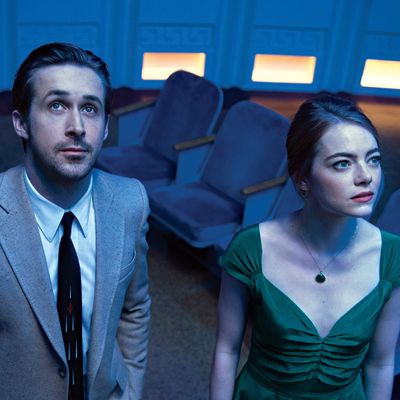
In his review of Damien Chazelle’s debut feature, the audacious microbudget 2010 musical Guy and Madeline on a Park Bench, the critic J. Hoberman wrote, “As an exercise in orchestrated time, each and every movie aspires to the state of music; those actually set to music are closest to their medium’s essence.” I can envision that sentence blown up and framed on Chazelle’s bedroom wall, maybe next to a poster of Jacques Demy’s The Umbrellas of Cherbourg. The romantic musical La La Land, the director’s third feature (following Whiplash), is the closest thing since Cherbourg to a unified-field theory of music and film. The moving camera extends the songs (most by Justin Hurwitz) into space. The colors of the sets and costumes hum with their own distinctive frequencies. The actors carry the music in their gait, their gestures, the rhythms of their speech, so that their singing and dancing is a small but exquisite step up from the way that they normally talk and walk. To rhapsodize about La La Land is to complete the experience. You want to sing its praises, literally.
Ryan Gosling and Emma Stone are the leads, meeting onscreen for the third time. Their first encounter, in Crazy, Stupid, Love, is memorable for the scene in which Stone is justifiably stunned by the sight of Gosling with his shirt off, laughing: “Seriously? It’s like you’re Photoshopped.” About their second affair, in Gangster Squad, the less said the better, though it’s a nice moment when police sergeant Gosling beholds Stone — a gangster’s moll in a dress slit way high — and cracks, “Who’s the tomato?” In La La Land, Gosling is a prickly, wiseacre jazz pianist named Sebastian, Stone a tremulous aspiring movie star named Mia. They meet cute in an L.A. traffic jam when she gives him the finger for stalling, but their first real chords are struck much later, when she’s passing a supper club and is drawn in by the sound of his playing. She sees him, the people in the restaurant fade away, and suddenly it’s just a boy and girl in twin spotlights.
That might sound campy, but Chazelle doesn’t wink at the audience and neither do the actors. The characters are so in-the-moment that the moment needs to swell to accommodate their feelings. After trading barbs at a Hollywood pool party (he’s a hired keyboardist), Sebastian and Mia stroll to a lookout over L.A., where, against the twinkling lights and violet sky, they’re so superhumanly gorgeous that they have to sing and dance, you know? Their song is called “A Lovely Night,” and Chazelle shoots it in one long take because that’s all you need. Gosling’s voice is thin but somehow very pleasing, while Stone’s is breathy but full and sweet. They’re not Astaire and Rogers — their dance steps are rather simple — but the elements gel and the number is magic.
My God, does the camera worship these two. Stone’s coloring — red hair, blue eyes, pale skin — just pops, and costume designer Mary Zophres makes her more vivid yet in bold, flouncy green and yellow and blue dresses. Production designer David Wasco adds complementary hues and an occasional neon sign to point up Stone’s wattage. Chazelle’s framing illuminates the pair’s insane chemistry. Tall and floppy and physically uninsistent, Gosling can settle too comfortably into his own adorableness. But you can’t be that self-involved opposite Stone. She’s too present. She knocks Gosling out of his sleepy tempos and makes him a great romantic-comedy hero.
And also, at times, an angry antagonist. La La Land finally centers on the conflict between Hollywood dreams and the reality of making art — not to mention a living in show business. The music stops (the needle actually comes to the end of a vinyl record) when Sebastian presses Mia to come with him to Boise, where he’s playing with a high-paying jazz-rock outfit. She shrugs him off: She has to stay in L.A. and finish an autobiographical monologue. For the writer-director of Whiplash, pursuing your art can mean pouring acid on the ties that bind you to other human beings. But Chazelle finds the melodic thread again in a bittersweet final fantasia that’s like nothing I’ve ever seen — a musical tour de force.
Inapt words are going to be used to describe La La Land, like pastiche and homage. It’s more than that. In one scene, Sebastian plays a record of a jazz pianist while sitting next to his own piano. He listens to a phrase, stops the record, and reproduces it. Then he does it all again. He’s slavishly imitating — but for the sake of getting inside the head of an artist he loves. That’s what Chazelle has done with musicals like The Umbrellas of Cherbourg and A Star Is Born and Singin’ in the Rain. He has learned their language, found their spark, and made their form triumphantly his own.
*This article appears in the November 28, 2016, issue of New York Magazine.


